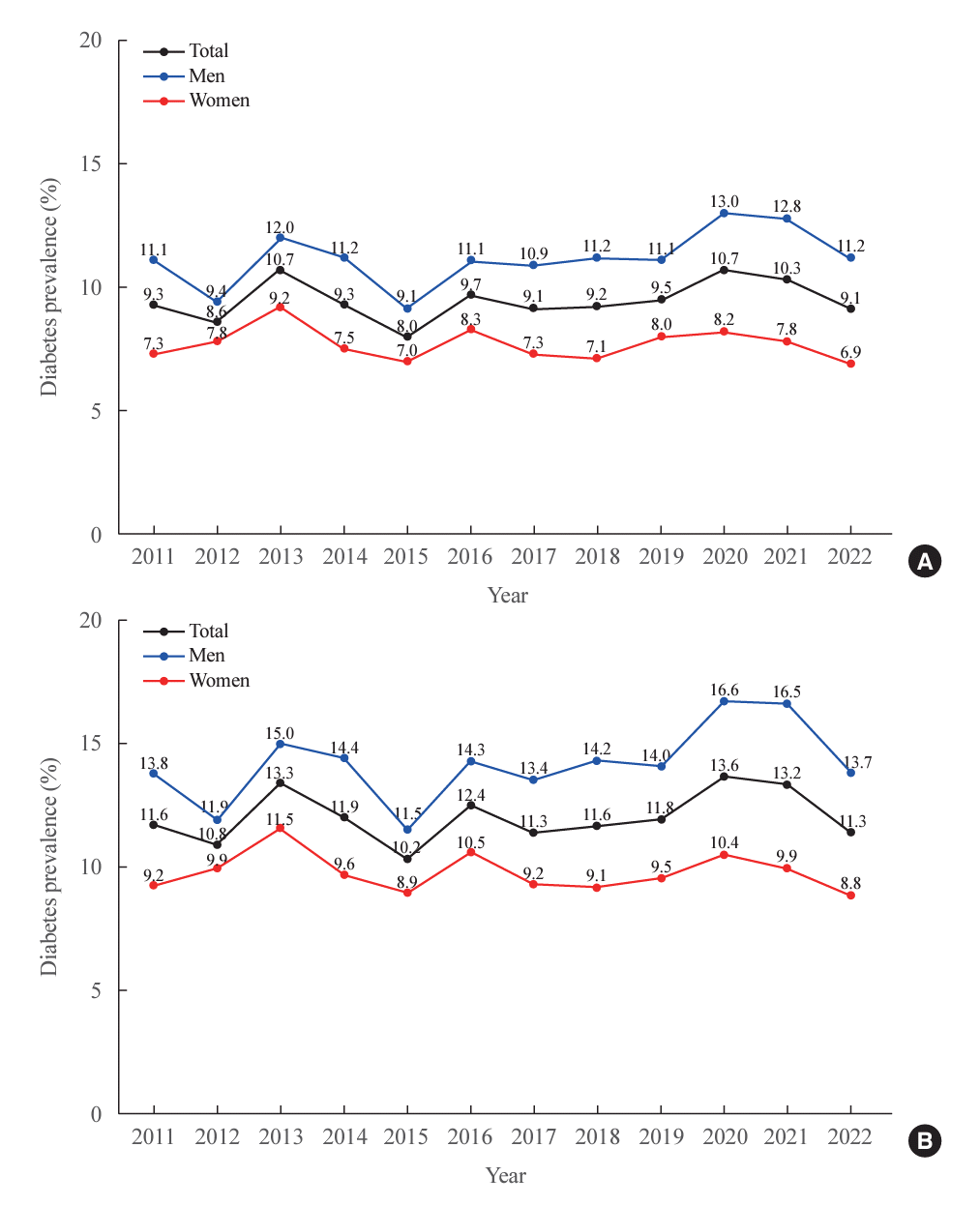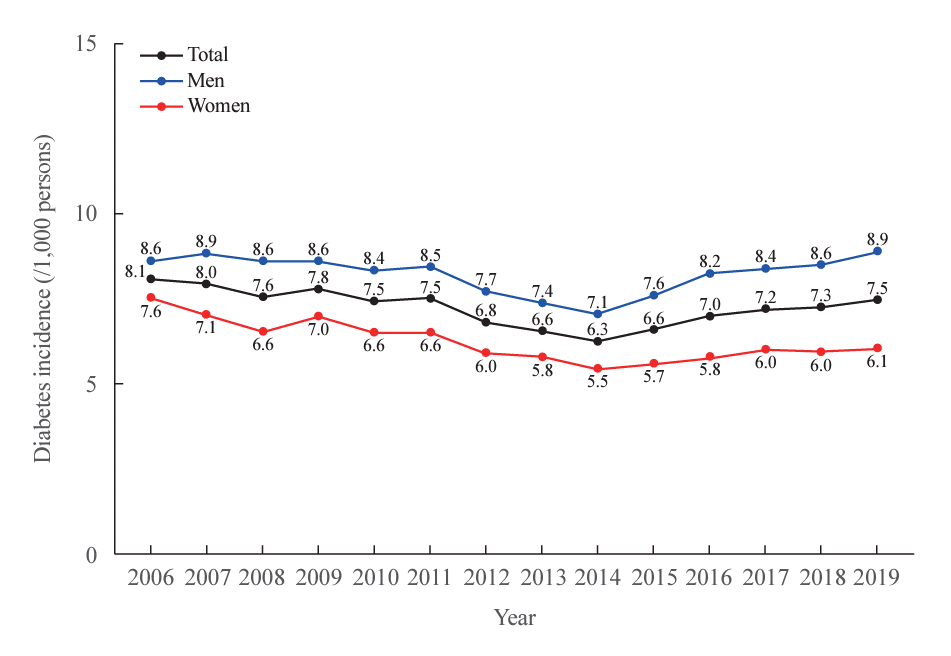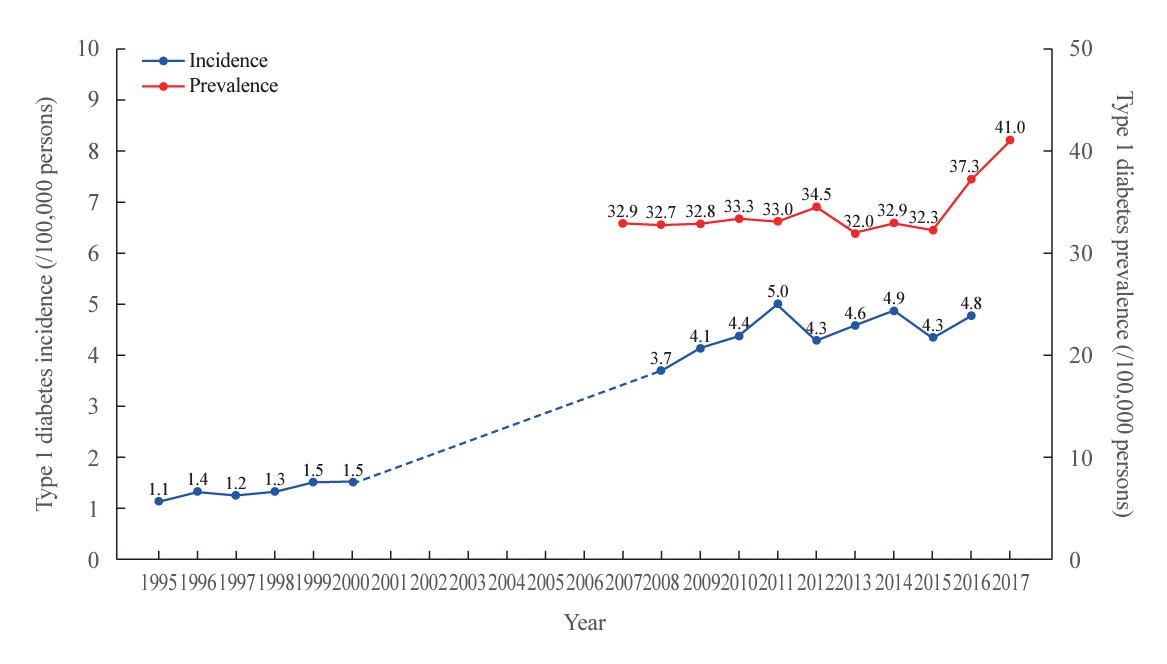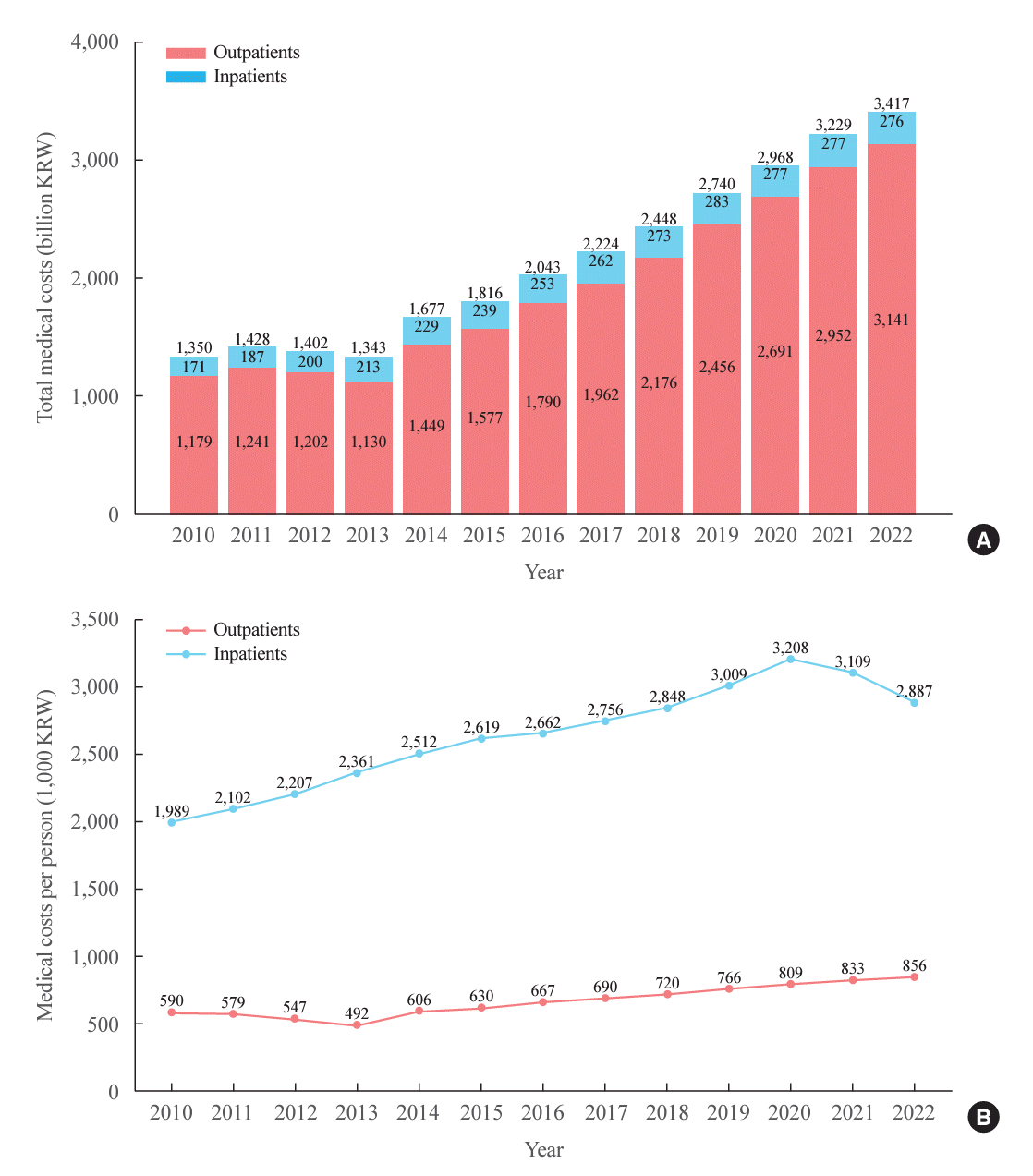1. Sun H, Saeedi P, Karuranga S, Pinkepank M, Ogurtsova K, Duncan BB, et al. IDF Diabetes Atlas: global, regional and country-level diabetes prevalence estimates for 2021 and projections for 2045. Diabetes Res Clin Pract. 2022; 183:109119.

2. Statistics Korea. Korean Statistical Information Service [Internet]. Daejeon: Statistics Korea;2024. [cited 2024 Aug 26]. Available from:
https://kosis.kr.
3. Lee GB, Kim Y, Park S, Kim HC, Oh K. Obesity, hypertension, diabetes mellitus, and hypercholesterolemia in Korean adults before and during the COVID-19 pandemic: a special report of the 2020 Korea National Health and Nutrition Examination Survey. Epidemiol Health. 2022; 44:e2022041.

4. Choi JH, Kim KM, Song K, Seo GH. Risk for newly diagnosed type 2 diabetes mellitus after COVID-19 among Korean adults: a nationwide matched cohort study. Endocrinol Metab (Seoul). 2023; 38:245–52.

5. Sinclair A, Saeedi P, Kaundal A, Karuranga S, Malanda B, Williams R. Diabetes and global ageing among 65-99-yearold adults: findings from the International Diabetes Federation Diabetes Atlas, 9th edition. Diabetes Res Clin Pract. 2020; 162:108078.

6. Ko SH, Han KD, Park YM, Yun JS, Kim K, Bae JH, et al. Diabetes mellitus in the elderly adults in Korea: based on data from the Korea National Health and Nutrition Examination Survey 2019 to 2020. Diabetes Metab J. 2023; 47:643–52.

7. Lee J, Kim HS, Song KH, Yoo SJ, Han K, Lee SH, et al. Risk of cause-specific mortality across glucose spectrum in elderly people: a nationwide population-based cohort study. Endocrinol Metab (Seoul). 2023; 38:525–37.

8. Magliano DJ, Chen L, Islam RM, Carstensen B, Gregg EW, Pavkov ME, et al. Trends in the incidence of diagnosed diabetes: a multicountry analysis of aggregate data from 22 million diagnoses in high-income and middle-income settings. Lancet Diabetes Endocrinol. 2021; 9:203–11.

9. Choi HH, Choi G, Yoon H, Ha KH, Kim DJ. Rising incidence of diabetes in young adults in South Korea: a national cohort study. Diabetes Metab J. 2022; 46:803–7.

10. Magliano DJ, Sacre JW, Harding JL, Gregg EW, Zimmet PZ, Shaw JE. Young-onset type 2 diabetes mellitus: implications for morbidity and mortality. Nat Rev Endocrinol. 2020; 16:321–31.

11. Ha KH, Park CY, Jeong IK, Kim HJ, Kim SY, Kim WJ, et al. Clinical characteristics of people with newly diagnosed type 2 diabetes between 2015 and 2016: difference by age and body mass index. Diabetes Metab J. 2018; 42:137–46.

12. Ha KH, Lee KA, Han KD, Moon MK, Kim DJ. Diabetes screening in South Korea: a new estimate of the number needed to screen to detect diabetes. Korean J Intern Med. 2023; 38:93–100.

13. Lee KA, Kim DJ, Han K, Chon S, Moon MK; Committee of Clinical Practice Guideline of Korean Diabetes Association. Screening for prediabetes and diabetes in Korean nonpregnant adults: a position statement of the Korean Diabetes Association, 2022. Diabetes Metab J. 2022; 46:819–26.

14. Holt RI, DeVries JH, Hess-Fischl A, Hirsch IB, Kirkman MS, Klupa T, et al. The management of type 1 diabetes in adults: a consensus report by the American Diabetes Association (ADA) and the European Association for the Study of Diabetes (EASD). Diabetes Care. 2021; 44:2589–625.

15. Yu J, Lee SH, Kim MK. Recent updates to clinical practice guidelines for diabetes mellitus. Endocrinol Metab (Seoul). 2022; 37:26–37.

16. Ogle GD, James S, Dabelea D, Pihoker C, Svennson J, Maniam J, et al. Global estimates of incidence of type 1 diabetes in children and adolescents: results from the International Diabetes Federation Atlas, 10th edition. Diabetes Res Clin Pract. 2022; 183:109083.

17. Shin CH. Epidemiologic characteristics of type 1 diabetes in children aged 14 years or under in Korea, 1985-2000. Korean J Pediatr. 2008; 51:569–75.

18. Chae HW, Seo GH, Song K, Choi HS, Suh J, Kwon A, et al. Incidence and prevalence of type 1 diabetes mellitus among Korean children and adolescents between 2007 and 2017: an epidemiologic study based on a national database. Diabetes Metab J. 2020; 44:866–74.

19. Korean Ministry of the Interior and Safety. Public Data Portal [Internet]. Sejong: Korean Ministry of the Interior and Safety;2024. [cited 2024 Aug 26]. Available from:
https://www.data.go.kr.
20. Park J, Kim G, Kim BS, Han KD, Kwon SY, Park SH, et al. Insulin fact sheet in type 1 and 2 diabetes mellitus and trends of antidiabetic medication use in insulin users with type 2 diabetes mellitus: 2002 to 2019. Diabetes Metab J. 2023; 47:211–9.

21. International Diabetes Federation. IDF Atlas reports: type 1 diabetes estimates in children and adults. Brussels: IDF;2021.
22. Choudhury AA, Devi Rajeswari V. Gestational diabetes mellitus: a metabolic and reproductive disorder. Biomed Pharmacother. 2021; 143:112183.
23. HAPO Study Cooperative Research Group, Metzger BE, Lowe LP, Dyer AR, Trimble ER, Chaovarindr U, et al. Hyperglycemia and adverse pregnancy outcomes. N Engl J Med. 2008; 358:1991–2002.

24. Wang H, Li N, Chivese T, Werfalli M, Sun H, Yuen L, et al. IDF Diabetes Atlas: estimation of global and regional gestational diabetes mellitus prevalence for 2021 by International Association of Diabetes in Pregnancy Study Group’s Criteria. Diabetes Res Clin Pract. 2022; 183:109050.

25. Al-Rifai RH, Abdo NM, Paulo MS, Saha S, Ahmed LA. Prevalence of gestational diabetes mellitus in the Middle East and North Africa, 2000-2019: a systematic review, meta-analysis, and meta-regression. Front Endocrinol (Lausanne). 2021; 12:668447.

26. Garmendia ML, Mondschein S, Montiel B, Kusanovic JP. Trends and predictors of gestational diabetes mellitus in Chile. Int J Gynaecol Obstet. 2020; 148:210–8.

27. Shah NS, Wang MC, Freaney PM, Perak AM, Carnethon MR, Kandula NR, et al. Trends in gestational diabetes at first live birth by race and ethnicity in the US, 2011-2019. JAMA. 2021; 326:660–9.

28. Su FL, Lu MC, Yu SC, Yang CP, Yang CC, Tseng ST, et al. Increasing trend in the prevalence of gestational diabetes mellitus in Taiwan. J Diabetes Investig. 2021; 12:2080–8.

29. Tantengco OA, Aquino IM, Asis JL, Tan JJ, Uy MN, Pacheco EP. Research trends in gestational diabetes mellitus in Southeast Asia: a bibliometric analysis (1975-2020). Diabetes Metab Syndr. 2021; 15:102202.

30. Jung CH, Jung SH, Choi D, Kim BY, Kim CH, Mok JO. Gestational diabetes in Korea: temporal trends in prevalence, treatment, and short-term consequences from a national health insurance claims database between 2012 and 2016. Diabetes Res Clin Pract. 2021; 171:108586.

31. Koo BK, Lee JH, Kim J, Jang EJ, Lee CH. Prevalence of gestational diabetes mellitus in Korea: a national health insurance database study. PLoS One. 2016; 11:e0153107.

32. Korean Diabetes Association. Diabetes fact sheet in Korea 2013. Seoul: Korean Diabetes Association;2013.
33. Health Insurance Review and Assessment Service. HIRA Bigdata Open portal [Internet]. Wonju: HIRA;2024. [cited 2024 Aug 26]. Available from:
https://opendata.hira.or.kr.
34. Li Y, Ren X, He L, Li J, Zhang S, Chen W. Maternal age and the risk of gestational diabetes mellitus: a systematic review and meta-analysis of over 120 million participants. Diabetes Res Clin Pract. 2020; 162:108044.

35. Cho GJ, Kim LY, Sung YN, Kim JA, Hwang SY, Hong HR, et al. Secular trends of gestational diabetes mellitus and changes in its risk factors. PLoS One. 2015; 10:e0136017.

36. Choi MJ, Choi J, Chung CW. Risk and risk factors for postpartum type 2 diabetes mellitus in women with gestational diabetes: a Korean nationwide cohort study. Endocrinol Metab (Seoul). 2022; 37:112–23.

37. Korean National Health Insurance Service. Korean National Health Insurance Statistical Yearbook (2010-2022) [Internet]. Wonju: Korean National Health Insurance Service;2024. [cited 2024 Aug 26]. Available from:
https://www.nhis.or.kr/nhis/index.do.







